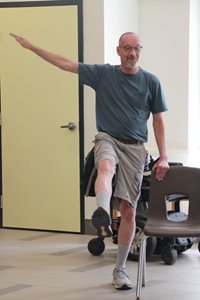July 14, 2023
.jpg.aspx?width=500&height=333)
Einat Danieli, clinical manager of Ambulatory Services at Baycrest Hospital, wants to bring the Community Falls Prevention Program to everyone’s doorstep, starting with Toronto’s seniors.
“We want to spread the program so that we have multiple locations and people can find locations close to their home to participate, stay active, and avoid falls,” Danieli explains. Her team currently runs the program on the Baycrest campus and at several Toronto Seniors Housing Corporation (TSHC) properties.
The course teaches participants to build the skills and body awareness needed to prevent falls. Each session includes strength-building workouts to upbeat music, core exercises that show how the human body keeps us balance, and education on what causes falls. For an hour and a half each week over 10 weeks, participants meet for a class that often takes place in the building they live in.
Nicole Campbell, a registered kinesiologist, is the clinician who runs the Falls Prevention Program. Each week, she demonstrates how different muscles are engaged as participants do strength repetitions, which are specifically focused on replicating motions they would encounter in their daily lives. This includes side-to-side steps that demonstrate how weight shifts from one leg to the other, the same step used to navigate a theatre or a galley kitchen.
“The most effective way to minimize the risk of a fall includes many factors. However, if you can only choose one thing, the best is exercise,” Campbell explains. Extensive evidence shows that exercising with a program that targets strength and balance prevents falls. Exercise also improves reaction times to respond to hazards and helps in achieving adequate flexibility to make adjustments and recover balance instead of falling.
This philosophy was key when choosing to have the classes in TSHC buildings, according to Danieli. Tenants in TSHC buildings who live in rent-geared-to-income (RGI) units may not have access to or be able to afford a regular exercise program or a gym membership.
Despite having the program at home, Campbell still meets participants later than she would like. “They’ve had a fall, or they know someone who had a fall that’s pretty catastrophic. The best time to join is before you’ve had a fall.”

It’s estimated that one in four adults over 65 will fall in a year, according to Danieli. Older adults who experience a fall have a higher risk of sustaining a serious injury and may not regain their previous level of function. “Preventing falls is one of the most important things in supporting aging in place,” she explains. Falls are currently the leading cause of injury-related hospital admissions for older adults.
The fear of leaving home can lead older adults not to get help after their first fall. However, two-thirds of older adults will fall a second time within a year. “They perceive the way to treat that is to be more careful, but they aren’t careful in the right ways,” explains Campbell.
“Something like this should be taken in your 50s,” Teresa MacDougall, a recent graduate of the program, says. “It just brings about a whole new awareness of your body.”
MacDougall says the course changed the way she navigates the world. She now puts on firm shoes in the morning instead of slippers, and turns on the light when navigating what she thinks is familiar territory.
“Nicole makes it so easy,” MacDougall explains, noting that Campbell builds a great environment and brings a lot of energy to the room.
Returning to a classroom not only allows older adults to learn fall prevention strategies, it also creates a community. “It really helps to hear others’ struggles,” MacDougall says.
.jpg.aspx?width=500&height=333)
Campbell has seen a positive response from tenants in the program. When peers can hold their own during a challenging demonstration of balance, the whole class cheers. “The program allows everyone to come together and learn they are not alone in this.”